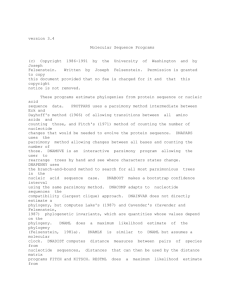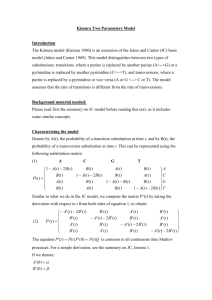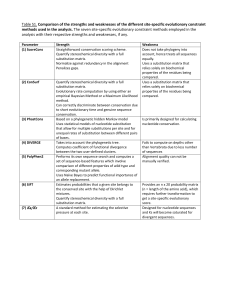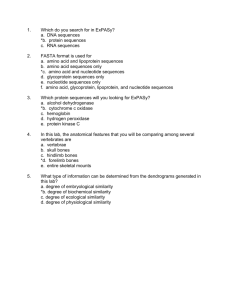Learn more by reading original document
advertisement
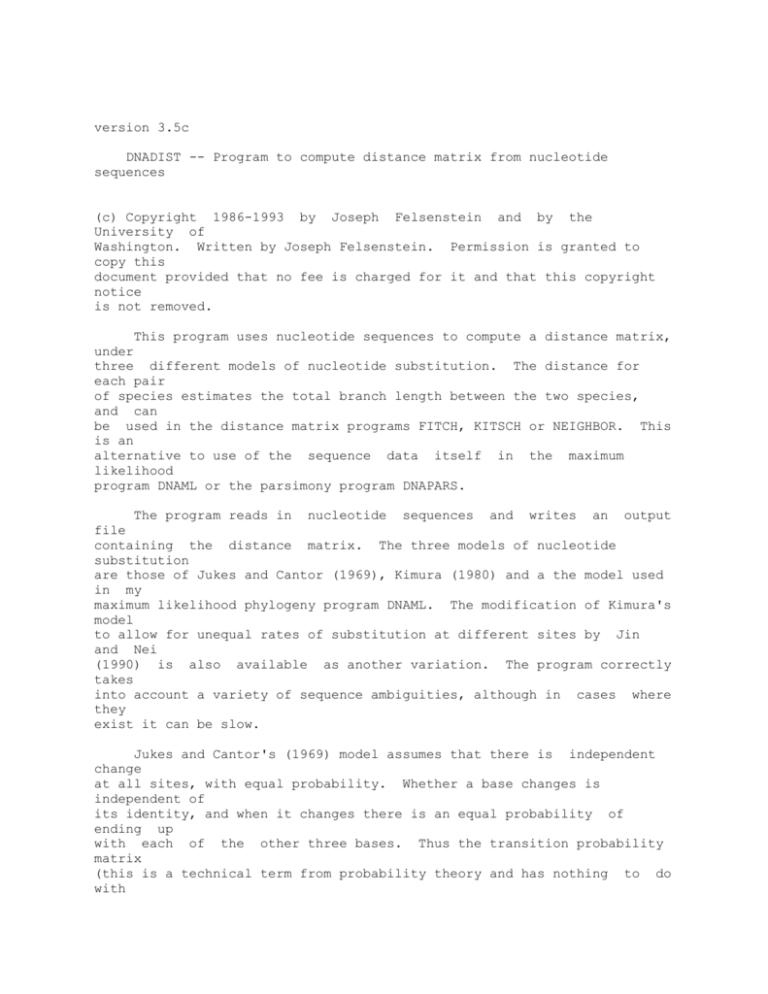
version 3.5c DNADIST -- Program to compute distance matrix from nucleotide sequences (c) Copyright 1986-1993 by Joseph Felsenstein and by the University of Washington. Written by Joseph Felsenstein. Permission is granted to copy this document provided that no fee is charged for it and that this copyright notice is not removed. This program uses nucleotide sequences to compute a distance matrix, under three different models of nucleotide substitution. The distance for each pair of species estimates the total branch length between the two species, and can be used in the distance matrix programs FITCH, KITSCH or NEIGHBOR. This is an alternative to use of the sequence data itself in the maximum likelihood program DNAML or the parsimony program DNAPARS. The program reads in nucleotide sequences and writes an output file containing the distance matrix. The three models of nucleotide substitution are those of Jukes and Cantor (1969), Kimura (1980) and a the model used in my maximum likelihood phylogeny program DNAML. The modification of Kimura's model to allow for unequal rates of substitution at different sites by Jin and Nei (1990) is also available as another variation. The program correctly takes into account a variety of sequence ambiguities, although in cases where they exist it can be slow. Jukes and Cantor's (1969) model assumes that there is independent change at all sites, with equal probability. Whether a base changes is independent of its identity, and when it changes there is an equal probability of ending up with each of the other three bases. Thus the transition probability matrix (this is a technical term from probability theory and has nothing to do with transitions as opposed to transversions) for a short period of time dt is: To: From: A G C T A G C T --------------------------------| 1-3a a a a | a 1-3a a a | a a 1-3a a | a a a 1-3a where a is u dt, the product of the rate of substitution per unit time (u) and the length dt of the time interval. For longer periods of time this implies that the probability that two sequences will differ at a given site is: - 4/3 u t p = 3/4 ( 1 - e ) and hence that if we observe p, we can compute an estimate of the branch length ut by inverting this to get ut = - 3/4 log ( 1 e - 4/3 p ) The Kimura "2-parameter" model is almost as symmetric as this, but allows for a difference between transition and transversion rates. Its transition probability matrix for a short interval of time is: To: From: A G C T A G C T --------------------------------| 1-a-2b a b b | a 1-a-2b b b | b b 1-a-2b a | b b a 1-a-2b where a is u dt, the product of the rate of transitions per unit time and dt is the length dt of the time interval, and b is v dt, the product of half the rate of transversions (i.e., the rate of a specific transversion) and the length dt of the time interval. The third model used is a model incorporating different rates of transition and transversion, but also allowing for different frequencies of the four nucleotides. It is the model which is used in DNAML, the maximum likelihood nucelotide sequence phylogenies program in this package. You will find the model described in the document for that program. The transition probabilities for this model are also given by Kishino and Hasegawa (1989). The three models are closely related. The DNAML model reduces to Kimura's two-parameter model if we assume that the equilibrium frequencies of the four bases are equal. The Jukes-Cantor model in turn is a special case of the Kimura 2-parameter model where a = b. Thus each model is a special case of the ones that follow it, Jukes-Cantor being a special case of both of the others. The Jin and Nei (1990) distance uses Kimura's model of base substitution, but assumes that the rate of substitution varies from site to site according to a gamma distribution, with a coefficient of variation that is specified by the user. The user is asked for it when choosing this option in the menu. Each distance that is calculated is an estimate, from that particular pair of species, of the divergence time between those two species. For the JukesCantor model, the estimate is computed using the formula for ut given above, as long as the nucleotide symbols in the two sequences are all either A, C, G, T, U, N, X, ?, or - (the latter four indicate a deletion or an unknown nucleotide. This estimate is a maximum likelihood estimate for that model. For the Kimura 2-parameter model, with only these nucleotide symbols, formulas special to that estimate are also computed. These are also, in effect, computing the maximum likelihood estimate for that model. In the Kimura case it depends on the observed sequences only through the sequence length and the observed number of transition and transversion differences between those two sequences. The calculation in that case is a maximum likelihood estimate and will differ somewhat from the estimate obtained from the formulas in Kimura's original paper. That formula was also a maximum likelihood estimate, but with the transition/transversion ratio estimated empirically, separately for each pair of sequences. In the present case, one overall preset transition/transversion ratio is used which makes the computations harder but achieves greater consistency between different comparisons. For the DNAML model, or for any of the models where one or both sequences contain at least one of the other ambiguity codons such as Y, R, etc., a maximum likelihood calculation is also done using code which was originally written for DNAML. Its disadvantage is that it is slow. The resulting distance is in effect a maximum likelihood estimate of the diveregence time (total branch length between) the two sequences. However the present program will be much faster than versions earlier than 3.5, because I have speeded up the iterations. Note that there is an assumption that we are looking at all sites, including those that have not changed at all. It is important not to restrict attention to some sites based on whether or not they have changed; doing that would bias the distances by making them too large, and that in turn would cause the distances to misinterpret the meaning of those sites that had changed. A major innovation in this program is that, for all of these distance methods, the program allows us to specify that "third position" bases have a different rate of substitution than first and second positions, that introns have a different rate than exons, and so on. The Categories option allows us to make up to 9 categories of sites and specify different rates of change for them. Note that this Categories option is different from the one used in DNAML and DNAMLK where you do not have to specify which sites are in which categories. INPUT FORMAT AND OPTIONS Input is fairly standard, with one addition. As usual the first line of the file gives the number of species and the number of sites. There follows the characters C or W if the Categories or Weights options are being used. Next come the species data. Each sequence starts on a new line, has a ten-character species name that must be blank-filled to be of that length, followed immediately by the species data in the one-letter code. The sequences must either be in the "interleaved" or "sequential" formats described in the Molecular Sequence Programs document. The I option selects between them. The sequences can have internal blanks in the sequence but there must be no extra blanks at the end of the terminated line. Note that a blank is not a valid symbol for a deletion. After that are the lines (if any) containing the information the C, and W options, as described below. The options are selected using an interactive menu. like The menu for looks this: Nucleic acid sequence Distance Matrix program, version 3.5c Settings for this run: D Distance (Kimura, Jin/Nei, ML, J-C)? T Transition/transversion ratio? C One category of substitution rates? L Form of distance matrix? M Analyze multiple data sets? I Input sequences interleaved? 0 Terminal type (IBM PC, VT52, ANSI)? 1 Print out the data at start of run 2 Print indications of progress of run Kimura 2-parameter 2.0 Yes Square No Yes ANSI No Yes Are these settings correct? (type Y or letter for one to change) The user either types "Y" (followed, of course, by a carriage-return) if the settings shown are to be accepted, or the letter or digit corresponding to an option that is to be changed. The options M and 0 are the usual ones. They are described in the main documentation file of this package. Option I is the same as in other molecular sequence programs and is described in the documentation file for the sequence programs. The D option selects one of the four distance methods. It toggles among the three methods. The default method, if none is specified, is the Kimura 2- parameter model. If the Nei/Jin distance is selected the user will be asked to supply the coefficient of variation of the rate of substitution among sites. This is different from the parameters used by Nei and Jin but related to them: their parameters a are related to the coefficient of variation by 1/2 CV = 1 / a or 2 a = 1 / (CV) (their parameter b is absorbed here by the requirement that time is scaled so that the mean rate of evolution is 1 per unit time, which means that a = b). As we consider cases in which the rates are less variable we should set a larger and larger, as CV gets smaller and smaller. The F (Frequencies) option appears when the Maximum Likelihood distance is selected. This distance requires that the program be provided with the equilibrium frequencies of the four bases A, C, G, and T (or U). Its default setting is one which may save users much time. If you want to use the empirical frequencies of the bases, observed in the input sequences, as the base frequencies, you simply use the default setting of the F option. These empirical frequencies are not really the maximum likelihood estimates of the base frequencies, but they will often be close to those values (what they are is maximum likelihood estimates under a "star" or "explosion" phylogeny). If you change the setting of the F option you will be prompted for the frequencies of the four bases. These must add to 1 and are to be typed on one line separated by blanks, not commas. The T option in this program does not stand for Threshold, but instead is the Transition/transversion option. The user is prompted for a real number greater than 0.0, as the expected ratio of transitions to transversions. Note that this is not the ratio of the first to the second kinds of events, but the resulting expected ratio of transitions to transversions. The exact relationship between these two quantities depends on the frequencies in the base pools. The default value of the T parameter if you do not use the T option is 2.0. The C (Categories) option is the one which species the relative rates of substitution at different sites. The sites are organized into up to nine categories. You are supposed to specify the relative rates of substitution in these categories. The category option asks you to specify how many categories there are to be (up to a maximum of 9) and then to enter the relative rates of change in the categories, as nonnegative real numbers typed on the same line separated by blanks, not commas. If you do not use the C option then there is in effect one category with rate 1.0. In addition to this line, use of the C option requires one piece of information, which associates sites with categories. That is one or more lines, which are placed after the initial line of the input file, and also after the lines containing the Weights, if any, but before the sequences. It consists of a line whose first characters are ignored, until the maximum length of a species name has been reached (it is therefore convenient, if species names are a maximum of ten characters as in the program as distributed, to put CATEGORIES in the first ten characters of that line, just to remind yourself what it is). The line then contains single digits (1 through 9) indicating which category each site is in. The information can continue to a new line anytime in the middle of these digits. For example the line may read: CATEGORIES 5555555555 5123123123 1231231231 2344444444 4441231235 5555 (that is an example imagining five categories for the three codon positions, intron positions, and flanking sequence positions). A site may in effect be dropped from the analysis by placing it in a category which has an extremely high rate of expected change. The L option specifies that the output file is to have the distance matrix in lower triangular form. The W (Weights) option is invoked in the usual way, with only weights 0 and 1 allowed. It selects a set of sites to be analyzed, ignoring the others. The sites selected are those with weight 1. If the W option is not invoked, all sites are analyzed. OUTPUT FORMAT As the distances are computed, the program prints on your screen or terminal the names of the species in turn, followed by one dot (".") for each other species for which the distance to that species has been computed. Thus if there are ten species, the first species name is printed out, followed by nine dots, then on the next line the next species name is printed out followed by eight dots, then the next followed by seven dots, and so on. The pattern of dots should form a triangle. When the distance matrix has been written out to the output file, the user is notified of that. The output file contains on its first line the number of species. The distance matrix is then printed in standard form, with each species starting on a new line with the species name, followed by the distances to the species in order. These continue onto a new line after every nine distances. If the L option is used, the matrix or distances is in lower triangular form, so that only the distances to the other species that precede each species are printed. Otherwise the distance matrix is square with zero distances on the diagonal. In general the format of the distance matrix is such that it can serve as input to any of the distance matrix programs. If the option to print out the data is selected, the output file will precede the data by more complete information on the input and the menu selections. The output file begins by giving the number of species and the number of characters, and the identity of the distance measure that is being used. If the C (Categories) option is used a table of the relative rates of expected substitution at each category of sites is printed, and a listing of the categories each site is in. There will then follow the equilibrium frequencies of the four bases. If the Jukes-Cantor or Kimura distances are used, these will necessarily be 0.25 : 0.25 : 0.25 : 0.25. The output then shows the transition/transversion ratio that was specified or used by default. In the case of the JukesCantor distance this will always be 0.5. The transition-transversion parameter (as opposed to the ratio) is also printed out: this is used within the program and can be ignored. There then follow the data sequences, with the base sequences printed in groups of ten bases along the lines of the Genbank and EMBL formats. The distances printed out are scaled in terms of expected numbers of substitutions, counting both transitions and transversions but not replacements of a base by itself, and scaled so that the average rate of change, averaged over all sites analyzed, is set to 1.0 if there are multiple categories of sites. This means that whether or not there are multiple categories of sites, the expected fraction of change for very small branches is equal to the branch length. Of course, when a branch is twice as long this does not mean that there will be twice as much net change expected along it, since some of the changes may occur in the same site and overlie or even reverse each other. The branch lengths estimates here are in terms of the expected underlying numbers of changes. That means that a branch of length 0.26 is 26 times as long as one which would show a 1% difference between the nucleotide sequences at the beginning and end of the branch. But we would not expect the sequences at the beginning and end of the branch to be 26% different, as there would be some overlaying of changes. One problem that can arise is that two or more of the species can be so dissimilar that the distance between them would have to be infinite, as the likelihood rises indefinitely as the estimated divergence time increases. For example, with the Jukes-Cantor model, if the two sequences differ in 75% or more of their positions then the estimate of dovergence time would be infinite. Since there is no way to represent an infinite distance in the output file, the program regards this as an error, issues an error message indicating which pair of species are causing the problem, and stops. It might be that, had it continued running, it would have also run into the same problem with other pairs of species. If the Kimura distance is being used there may be no error message; the program may simply give a large distance value (it is iterating towards infinity and the value is just where the iteration stopped). Likewise some maximum likelihood estimates may also become large for the same reason (the sequences showing more divergence than is expected even with infinite branch length). I hope in the future to add more warning messages that would alert the user the this. PROGRAM CONSTANTS at The constants that are the available to be changed by the user beginning of the program include "maxcategories", the maximum number of site categories, "iterations", which controls the number of times the program iterates the EM algorithm that is used to do the maximum likelihood distance, "namelength", the length of species names in characters, and "epsilon", a parameter which controls the accuracy of the results of the iterations which estimate the distances. Making "epsilon" smaller will increase run times but result in more decimal places of accuracy. This should not be necessary. The program spends most of its time doing real arithmetic. Any software or hardware changes that speed up that arithmetic will speed it up by a nearly proportional amount. For example, microcomputers that have a numeric coprocessor (such as an 8087, 80287, or 80387 chip) will run this program much faster than ones that do not, if the software calls it. The algorithm, with separate and independent computations occurring for each pattern, lends itself readily to parallel processing. --------------------------------TEST DATA SET-------------------------5 13 Alpha Beta Gamma Delta Epsilon AACGTGGCCACAT AAGGTCGCCACAC CAGTTCGCCACAA GAGATTTCCGCCT GAGATCTCCGCCC ------ CONTENTS OF OUTPUT FILE (with all numerical options on ) ---------Nucleic acid sequence Distance Matrix program, version 3.5c 5 species, 13 sites Kimura 2-parameter Distance Base Frequencies: A 0.25000 C 0.25000 G 0.25000 T(U) 0.25000 Transition/transversion ratio = 2.000000 (Transition/transversion parameter = Name ---Alpha Beta Gamma Delta Epsilon 5 Alpha Beta Gamma Delta Epsilon 1.500000) Sequences --------AACGTGGCCA ..G..C.... C.GT.C.... G.GA.TT..G G.GA.CT..G 0.0000 0.2997 0.7820 1.1716 1.4617 CAT ..C ..A .C. .CC 0.2997 0.0000 0.3219 0.8997 0.5653 0.7820 0.3219 0.0000 1.4481 1.0726 1.1716 0.8997 1.4481 0.0000 0.1679 1.4617 0.5653 1.0726 0.1679 0.0000

